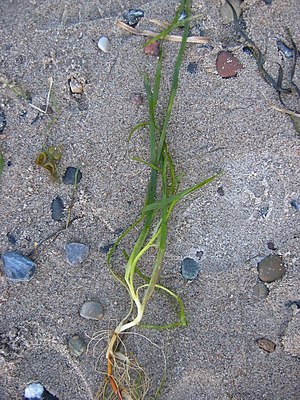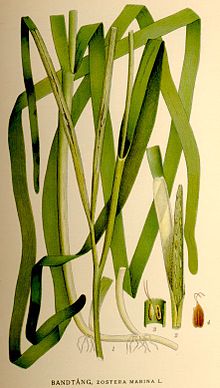Seagrass
| Seagrass | ||||||||||||
|---|---|---|---|---|---|---|---|---|---|---|---|---|

Seaweed |
||||||||||||
| Systematics | ||||||||||||
|
||||||||||||
| Scientific name | ||||||||||||
| Zosteraceae | ||||||||||||
| Dumort. |
The seagrass family (Zosteraceae) are a small family of plants from the order of the frog-spoon-like (Alismatales). The only two to four genera with up to 20 species thrive as submerged aquatic plants in salt water in coastal areas almost worldwide, but largely outside of the tropics.
description

Vegetative characteristics
Seagrass plants are usually perennial , rarely annual , herbaceous plants that grow under water ( submersed ) and often form carpet-like dense stands in the coastal regions of the seas. They anchor themselves in the sea floor through monopodial sprouting rhizomes with adventitious roots without lateral roots. Since they look like grass, the common name seaweed is common for them, as well as for many other species of frog-spoon-like (Alismatales) that grow in the sea .
The alternate leaves are arranged in two rows and consist of a leaf sheath and a leaf blade, without a petiole. The edges of the leaf sheaths can touch; they are more durable than the leaf blades and disintegrate into fiber bundles. The long, ribbon-like leaf blades are simple, linear, with entire margins and parallel veins without network nerves. There are scales on the leaf axils. The leaves have a persistent basal meristem that allows them to continue growing from their base. There are no stomata .
Generative characteristics
Seagrass plants are monoecious ( monoecious ) or dioecious ( dioecious ) separate sexes. There are lateral or terminal inflorescences formed on a more or less long inflorescence stem. The inflorescences have the usual structure for frog-spoon-like structure: an inflorescence axis (spadix), which are enclosed (surrounded by it) in a single bract ( spathe ). The flattened spadix has many flowers on only one side. The flowers are often above a cover sheet .
The always functionally unisexual flowers are reduced and do not have a flower cover . The male flowers contain only one stamen and the anthers open longitudinally. The three-cell pollen grains have no apertures. The female flowers contain an upper ovary , which consists of two fused carpels , but apparently only consists of one carpel. Each ovary contains only one sedentary, pendulous, orthotropic, bitegmic, pseudocrassinucellate ovule . The pollination is carried out in the water by so-called thread pollen.
There are achänenähnliche , seeded Nuts formed. The seeds do not contain an endosperm , but do contain a straight embryo with a cotyledon . The membranous seed coat (testa) does not contain any phytomelanins.
The chromosomes are 0.9 to 1.6 µm long. The basic chromosome numbers are x = 6, 9, 10.
Occurrence
The 20 or so species are found in the temperate to subtropical zones around the world, but not in tropical warm salt water. They are absent in the Caribbean, as well as on the east coast of South America and the western coasts of Africa.
They grow on the ocean floor, in coastal waters also in the tidal area . In the coastal regions of East Africa they reach as far as the Cape of Good Hope and reach Madagascar. Because of the cool Pacific ocean currents, they can be found off the Chilean coast of South America. Stocks also exist between Australia and New Zealand. They are just as common in the North Pacific as in the North Atlantic; on the Chinese coasts there are two genera and seven species, on the North American coasts two genera and five species.
Systematics

The Zosteraceae family was established in 1829 by Barthélemy Charles Joseph Dumortier in Analyze des Familles de Plantes , pp. 65-66. The type genus is Zostera L.
The Zosteraceae family contains only two to four genera with 18 to 20 species. The scope and delimitation of the genres is controversial:
- Heterozostera (Setch.) Hartog (whether their species are included in Zostera is controversial): The one to four species occur on the sea coasts mainly in the southern hemisphere .
- Nanozostera Toml. & Posl. (Whether its species are included in Zostera is controversial): It contains up to four species.
- Phyllospadix Hook. : The five to six species occur on the coasts of the northern Pacific from Russia's Far East to Japan and from western Canada to northwestern Mexico.
- Zostera L .: The 13 to 16 species occur on the coasts of the northern hemisphere (if s. Left also southern hemisphere). According to Jacobs & Les 2009, it also contains the species of the genera Heterozostera and Zosterella and is divided into three subgenera: Zostera subgen. Zostera , Zostera subgen. Heterozostera and Zostera subgene. Zosterella .
swell
- The family of Zosteraceae in APWebsite. (Sections systematics and description)
- The Zosteraceae family at DELTA. (Section description)
- JA Coyer, G. Hoarau, J. Kuo, A. Tronholm, J. Veldsink, JL Olsen: Phylogeny and temporal divergence of the seagrass family Zosteraceae using one nuclear and three chloroplast loci . In: Systematics and Biodiversity . tape 11 , no. 3 , September 2013, ISSN 1477-2000 , p. 271–284 , doi : 10.1080 / 14772000.2013.821187 (English).
- Robert R. Haynes: Zosteraceae. - Same text online as the printed work , In: Flora of North America Editorial Committee (Ed.): Flora of North America North of Mexico . Volume 22: Magnoliophyta: Alismatidae, Arecidae, Commelinidae (in part), and Zingiberidae . Oxford University Press, New York / Oxford a. a. 2000, ISBN 0-19-513729-9 (English). (Sections Description and Distribution)
- Youhao Guo, Robert R. Haynes & C. Barre Hellquist: Zosteraceae . In: Wu Zheng-yi, Peter H. Raven & Deyuan Hong (Eds.): Flora of China . Acoraceae-Cyperaceae. Volume 23. Science Press and Missouri Botanical Garden Press, Beijing et al. 2010, ISBN 978-1-930723-99-3 , pp. 106-108 (English, “ Zosteraceae - Online ” - online text is identical to the printed work; printed work - full text online). (Sections Description, Systematics and Distribution)
- Leslie Watson, 2008: Entry in the Western Australian Flora . (Section description)
- SWL Jacobs & DH Les: New combinations in Zostera (Zosteraceae) , In: Telopea 12, 2009, pp. 419-423. ISSN 0312-9764 PDF .
Individual evidence
- ↑ a b Rafaël Govaerts (Ed.): Zosteraceae. In: World Checklist of Selected Plant Families (WCSP) - The Board of Trustees of the Royal Botanic Gardens, Kew . Retrieved June 7, 2020.
- ^ Zosteraceae in the Germplasm Resources Information Network (GRIN), USDA , ARS , National Genetic Resources Program. National Germplasm Resources Laboratory, Beltsville, Maryland.
- ^ John Kuo: A revision of the genus Heterozostera (Zosteraceae) , In: Aquatic Botany , Volume 81, Issue 2, 2005, pp. 97-140. ISSN 0304-3770